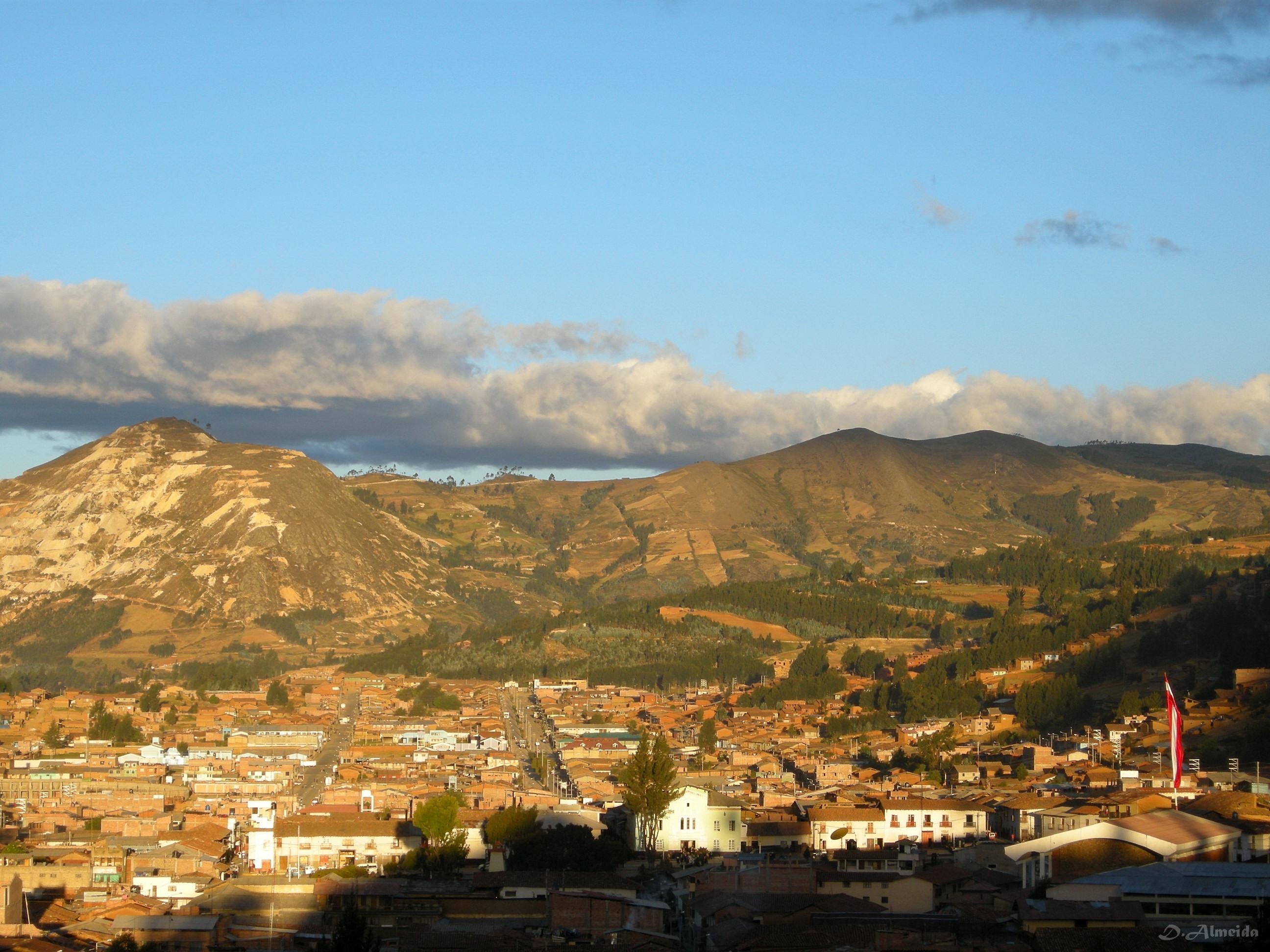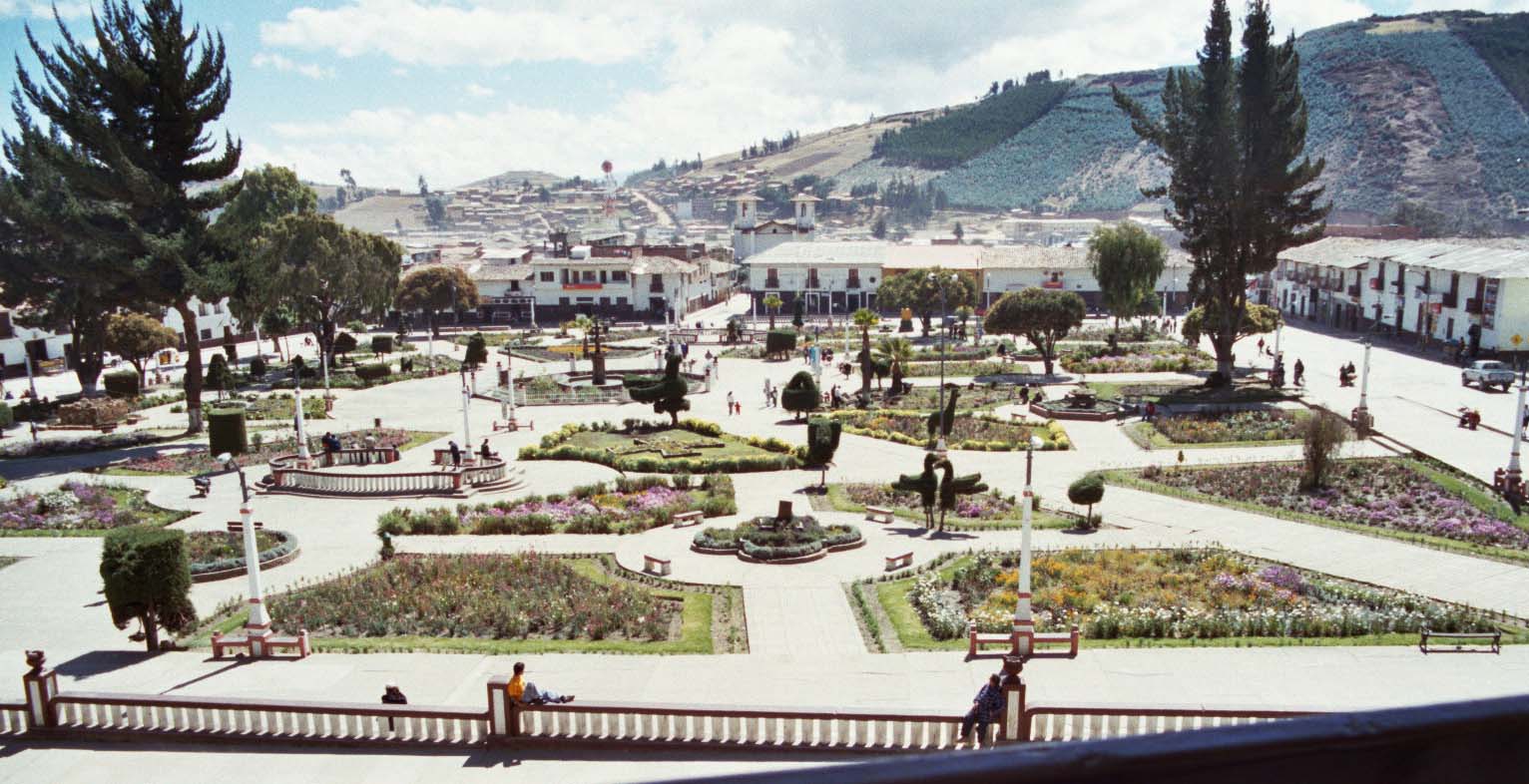Huamachuco on:
[Wikipedia]
[Google]
[Amazon]


 Huamachuco (possibly from Quechua ''waman'', falcon or variable hawk, and Kulyi ''chuco'', earth or land, "land of falcons") is a town in northern
Huamachuco (possibly from Quechua ''waman'', falcon or variable hawk, and Kulyi ''chuco'', earth or land, "land of falcons") is a town in northern
 Huamachuco's deep valley slopes show evidence of deliberate farming of native Andean trees and shrub vegetation. It appears that in prehistoric times, the temperature of the land was slightly warmer than today, allowing agriculture at elevations 100–300 m. higher than is possible in the 20th and 21st centuries.
Huamachuco's deep valley slopes show evidence of deliberate farming of native Andean trees and shrub vegetation. It appears that in prehistoric times, the temperature of the land was slightly warmer than today, allowing agriculture at elevations 100–300 m. higher than is possible in the 20th and 21st centuries.
Official municipal website
{{Coord, 7, 48, 43.3, S, 78, 2, 55.3, W, region:PE_type:city, display=title Cities in La Libertad Region Populated places in La Libertad Region Populated places established in 1553


 Huamachuco (possibly from Quechua ''waman'', falcon or variable hawk, and Kulyi ''chuco'', earth or land, "land of falcons") is a town in northern
Huamachuco (possibly from Quechua ''waman'', falcon or variable hawk, and Kulyi ''chuco'', earth or land, "land of falcons") is a town in northern Peru
, image_flag = Flag of Peru.svg
, image_coat = Escudo nacional del Perú.svg
, other_symbol = Great Seal of the State
, other_symbol_type = Seal (emblem), National seal
, national_motto = "Fi ...
and capital of the province Sánchez Carrión in La Libertad Region
La Libertad (; in English: ''The Liberty'') is a region in northwestern Peru. Formerly it was known as the Department of La Libertad ('). It is bordered by the Lambayeque, Cajamarca and Amazonas regions on the north, the San Martín Region on ...
. The city is the seat of the Territorial Prelature of Huamachuco. Lake Sausacocha
Lake Sausacocha ( es, Laguna Sausacocha, qu, Sawsaqucha) is a lake in Peru, to the northeast of Huamachuco in Huamachuco District, Sánchez Carrión Province. Literal meaning of Sausacocha is "lagoon that never dries." Overgrazed hillsides sur ...
lies to the northeast.
About 30 miles away, within the Huamachuco district, is the significant archeological site of Marcahuamachuco
Marcahuamachuco is an archeological site of Pre-Incan ruins in the La Libertad Region of Peru. Although less well-known than other sites, it is considered significant and has been referred to by archaeologists as " Machu Picchu of the North" a ...
. It is a complex of monuments, a prehistoric political and religious center of a culture that thrived 350 CE-1100 CE. The ruins of a Wari city, Viracochapampa
Viracochapampa, Huiracochapampa, or Wiracochapampa (possibly from Quechua ''wiraqucha'': mister, sir, gentleman, god; or '' Wiracocha'': one of the greatest Andean divinities; and ''pampa'': plain)Teofilo Laime Ajacopa, Diccionario Bilingüe Isk ...
, are located 3.5 km north of Huamachuco. Additionally there are many other pre-Columbian ruins around the town.
History
The area surrounding the town exhibits early occupations of ancient Andean civilizations. Before the advent of the Incas the area was united under a single political entity referred to as the "Señorio de Huamachuco" (Huamachuco lordship) by colonial chroniclers, a Kulyi-speaking polity that had as their main deity the thunder god of Catequil, an oracle and the principal ''wak'a'' of the Huamachucos, later incorporated into the official Inca pantheon, whose shrine was located in the center of Huamachucos' territory, archaeologists have identified the mountain of Cerro Icchal with Catequil (both as the seat of the wak'a and as the wak'a himself), the ruins of Namanchugo, Catequil's main sanctuary, are situated at the hillfoot of the Cerro Icchal mountain, although it has been largely destroyed by Atawallpa and colonial priests, its magnificence and importance was recorded by colonial chroniclers, Catequil was a famous god venerated through the northern Peruvian highlands and beyond since pre-Inca times, pilgrims seeking to find answers were one of the main sources of income to the Huamachucos, the shrine prosperity is perhaps one of the reasons why the area surrounding Huamachuco does not seem to have been seriously affected, as large parts of the Peruvian highlands were, by the demographic collapse following the end of the Middle Horizon era (Wari state's demise), rather population growth appears to be continuous in the area. Indigenous settlement patterns within the Huamachuco area can be divided into 8 phases: *Colpa phase (? to 900 BC) *Sausagocha phase (900 - 200 BC) *Purpucala phase (200 BC - AD 300) *Early-Huamachuco phase (AD 300 - 600) *Amaru phase (AD 600 - 800?) *Late-Huamachuco phase (AD 800? - 1000) *Tuscan phase (AD 1000 - 1470) *Santa Bárbara phase (AD 1470 - 1532). The Tuscan phase, the penultimate phase, corresponds to the historical autonomous domain of Huamachuco. And the Santa Barbara phase corresponds to the Inca domination of Huamachuco. The Huamachuco domain or kingdom probably established its capital at Marcahuamachuco, the ruins of Marcahuamachuco shows evident occupation since the Early-Huamachuco phase up to the Tuscan phase. Following the Inca conquest, the Marcahuamachuco population was likely resettled where the modern town of Huamachuco stands today. The town of Huamachuco was originally built by the Inca as their main installation in the zone, Huamachuco became the capital seat of an Inca province ( ''wamani'') of the same name. The Inca town of Huamachuco doesn't seem to have been built upon any previous settlement, the pre-Inca hill fort of Cerro Tuscán, overlooking the town, seems to have been enhanced to protect the Inca settlement. With the Incas came enclaves of settlers called ''mitmaqkuna'' and an extensive system of tambos was built in the area, both things supported by archaeological research. The Inca administrative center of Huamachuco was a stopover on the main Inca highway of Cusco to Quito, the " Qhapaq Ñan" or "Royal Road". The Incas built at least 215colca
A qullqa ( "deposit, storehouse"; (spelling variants: ''colca, collca, qolca, qollca'') was a storage building found along roads and near the cities and political centers of the Inca Empire. To a "prodigious xtentunprecedented in the annals of ...
storehouses on the hillslopes surrounding the town, roughly half of these have floors elevated on stone pillars, the other storerooms have canals running under the floors, these were probably for tubers. The Spanish foundation of Huamachuco was made in 1553 by Augustinian missionaries on top of Inca's Huamachuco. During the Peruvian War of Independence
The Peruvian War of Independence ( es, Guerra de Independencia del Perú, links=no) consisted in a series of military conflicts in Peru beginning with viceroy Abascal military victories in the south frontier in 1809, in La Paz revolution a ...
, it was named as a very illustrious and faithful city by General Jose de San Martin. During the War of the Pacific
The War of the Pacific ( es, link=no, Guerra del Pacífico), also known as the Saltpeter War ( es, link=no, Guerra del salitre) and by multiple other names, was a war between Chile and a Bolivian–Peruvian alliance from 1879 to 1884. Fought ...
, Huamachuco was the scene of the Battle of Huamachuco
The Battle of Huamachuco was fought on the 10 July 1883, and it was the last major battle of the War of the Pacific. The Chilean soldiers, led by Colonel Alejandro Gorostiaga, decisively defeated the Peruvian army commanded by General Andrés Av ...
(10 July 1883), the final episode of the Pacific War where troops led by Andrés Avelino Cáceres
Andrés Avelino Cáceres Dorregaray (November 10, 1836 – October 10, 1923) served as the President of Peru two times during the 19th century, from 1886 to 1890 as the 27th President of Peru, and again from 1894 to 1895 as the 30th Preside ...
were defeated by Chilean troops under Colonel Alejandro Gorostiaga.
Etymology
It is not clear whether the name of the city comes from the Kulyi language, the autochthonous language of the area, or from Quechua, a language from central Peru that reached its heyday during theInca Empire
The Inca Empire (also known as the Incan Empire and the Inka Empire), called ''Tawantinsuyu'' by its subjects, ( Quechua for the "Realm of the Four Parts", "four parts together" ) was the largest empire in pre-Columbian America. The adm ...
. Most scholars believe the name to be of a mixed origin between both languages, it would mean "land of falcons" or "country of falcons". The name Huamachuco can be divided into two words, "huama" and "chuco", it has been postulated that ''huama'' comes from the Quechua word ''waman'' which means falcon, as it has no known meaning in Kulyi, a poorly attested extinct language, while ''chuco'' is of likely Kulyi origin, meaning earth, land, region, or country, being a commonly used term throughout the toponymy of the region, alternatively written as ''chugo''. Otherwise, ''chuco'' can be translated as helmet or headwear in Quechua, which would give the city the meaning of "falcon hat", however, modern linguists deny that such is the right meaning of the city's name.
Geography
Huamachuco is located between the eastern and western cordillera of the Andes Mountains, and 100 km south ofCajamarca
Cajamarca (), also known by the Quechua name, ''Kashamarka'', is the capital and largest city of the Cajamarca Region as well as an important cultural and commercial center in the northern Andes. It is located in the northern highlands of Peru ...
.
It has highland areas that range from 2500 to 4500 m. above sea level. Because of the heights, most of Huamachuco's land is treeless. The high-altitude grassland is known as '' puna''. The highland is bounded on the east and west by two parallel sierra ranges. The ''puna'' grasslands were ideal habitats for deer and wild camelids. They also supported the domesticated camelids: alpacas and llamas.
Banks
*Branch of Caja Trujillo. *Branch of Nuestra Gente. *Branch of Banco de la Nacion. *Branch of Caja Piura.See also
* Feast of Saint Francis *Marcahuamachuco
Marcahuamachuco is an archeological site of Pre-Incan ruins in the La Libertad Region of Peru. Although less well-known than other sites, it is considered significant and has been referred to by archaeologists as " Machu Picchu of the North" a ...
*La Libertad Region
La Libertad (; in English: ''The Liberty'') is a region in northwestern Peru. Formerly it was known as the Department of La Libertad ('). It is bordered by the Lambayeque, Cajamarca and Amazonas regions on the north, the San Martín Region on ...
*Racing de Huamachuco
Racing is a Peruvian football club, playing in the city of Huamachuco, Peru. The club was founded 1946 and play in the Copa Perú which is the third division of the Peruvian league.
History
In the 2014 Copa Perú, the club classified to the Reg ...
*Trujillo, Peru
, population_note =
, postal_code_type = Postal code
, postal_code = 13001
, area_code = 044
, website Municipality of Trujillo, footnotes ...
References
External links
*Official municipal website
{{Coord, 7, 48, 43.3, S, 78, 2, 55.3, W, region:PE_type:city, display=title Cities in La Libertad Region Populated places in La Libertad Region Populated places established in 1553